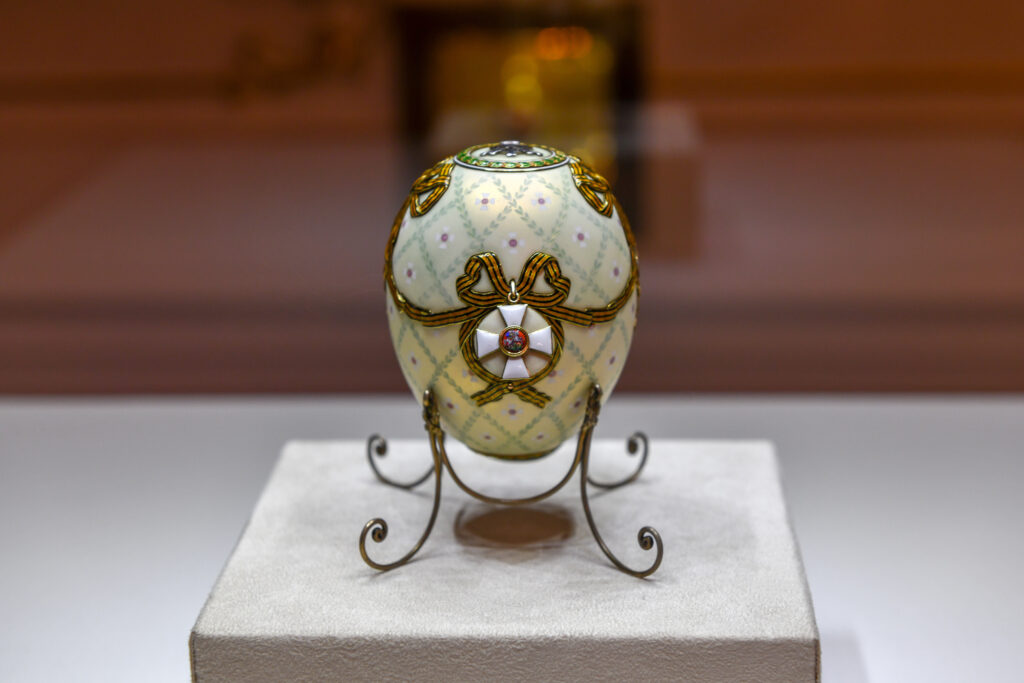Fabergé eggs are some of the most opulent and legendary items in the jewelry world, but why are they so famous?
Fabergé eggs are so impossibly famous for a few reasons. Firstly, less than sixty of the ‘original’ Fabergé eggs exist today. Secondly, they’re dramatically expensive and are lined with precious metals, gems, and jewels. Lastly, every single Fabergé egg is intensely unique and individual.

Read on to learn more about Fabergé eggs, how they came to exist, and where they are today.
Don’t Crack This Egg
Peter Carl Fabergé was already a very successful Russian jeweler when he was approached by Tsar Alexander III. The then-premier in Russia had a unique request; he wanted to gift his wife, Maria Fyodorovna, an extravagant and opulent egg for Easter.
However, this egg would be like no other, and it certainly wasn’t laid by a hen, or made of chocolate. This egg was the very first Fabergé, known as the ‘First Hen’, and it consisted of four layers, opening one after the other.
Inside the outer shell was a golden yolk, and inside the yolk was a golden hen, with eyes of ruby. If you opened up the golden hen, the final surprise was revealed; a miniature replica of the imperial crown.
The Tsar was so impressed by the craftsmanship and accuracy that Peter Carl Fabergé had poured into the egg, that he set up a ‘standing order’ for more. In total, around seventy Fabergé eggs would come to be created, with less than sixty surviving today.
Every year, on Easter, Tsar Alexander III would gift his wife another egg, each iteration more beautiful than the last. Peter Carl Fabergé was given the gift of total freedom with these eggs, and it was his creative vision that made them so impressive.
When Alexander III passed away, the tradition was assumed by his son, Nicholas II. However, it wasn’t to be an extremely long-lived tradition, owing to the events in 1918 that led to Nicholas’ death.
From 1917 to 1923, Russia found itself in the midst of several revolutions, which ultimately saw the execution of the entire Romanov dynasty. Of course, this included Nicholas II, and following his death, his riches and heirlooms were confiscated by the new government.
This is allegedly the reason why so many Fabergé eggs are lost or assumed destroyed. It’s thought that as many as a dozen eggs, whose value would be incalculable, were lost to the revolution.
An Egg Like No Other
That origin story is enough to establish why Fabergé eggs are so famous, but we won’t stop there.
At their very foundation, Fabergé eggs are some of the finest jeweled items on the planet, and likely always will be. They all went through a painstaking and intense design process and were built by only the finest craftsmen.
They often featured intricate designs that incorporated dozens, if not hundreds of fine gems, pearls, stones, and layers of precious metal. The leading reason behind the high value of every egg is that each one is totally unique; no eggs were duplicated or gave inspiration to the next egg.
Carl Peter Fabergé also went on to make eggs that went unsold, or that were commissioned by a man called Alexander Ferdinandovich Kelch. However, the latter eggs weren’t as extravagant as the imperial collection, and so had a slightly lower value.
Where Are They Now?
Today, these eggs can be found in many places, all around the world. There are some in British, American, or Russian museums, and some in art galleries.
However, the biggest collection of Fabergé eggs belongs to a private owner, Viktor Vekselberg, a Russian oligarch. He’s dramatically rich, with a net worth of more than ten billion dollars, and he owns sixteen of the surviving eggs and other related Fabergé items.
At their highest value, some of these eggs are worth as much as thirty-three million dollars. As a whole, the collection would quite simply be priceless, and it’s impossible to calculate the value of the lost eggs.
So, that clearly explains why they’re so famous, in a few simple steps.
There are less than sixty in the entire world, they cannot be created anymore (at least, not officially), and they’re massively expensive. Aside from unique, super-rare gemstones, there are likely no other objects in the jewelry world that are more coveted or sought-after.
